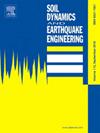主余震序列加载下软黏土循环剪切特性的能量评价
IF 4.2
2区 工程技术
Q1 ENGINEERING, GEOLOGICAL
引用次数: 0
摘要
一组地震通常由一次主震和多次余震组成。研究连续地震荷载作用下土体的动力特性是至关重要的。本文对原状软土在不同循环应力幅值和再固结程度下进行了一系列循环单剪试验。根据地震烈度和土体埋深计算等效地震剪应力。此外,在加载区间进行了再固结,以研究地震历史的影响。建立了累积耗散能量随循环次数变化的经验模型。采用能量耗散原理研究了循环剪切应变和等效孔隙压力的演化规律。研究结果表明,随着循环应力幅值的增大,余震荷载对土骨架结构的增量损伤越严重。这表现为变形的逐渐增大和耗散能量的迅速积累。同时,再固结过程通过抑制土体颗粒间的错位和滑移,减小了能量耗散程度,从而增强了软粘土对后续动力加载的抵抗力。本文章由计算机程序翻译,如有差异,请以英文原文为准。
Energy-based evaluation of cyclic shear behaviors of soft clay under mainshock-aftershock sequence loading
A group of earthquakes typically consists of a mainshock followed by multiple aftershocks. Exploration of the dynamic behaviors of soil subjected to sequential earthquake loading is crucial. In this paper, a series of cyclic simple shear tests were performed on the undisturbed soft clay under different cyclic stress amplitudes and reconsolidation degrees. The equivalent seismic shear stress was calculated based on the seismic intensity and soil buried depth. Furthermore, reconsolidation was conducted at the loading interval to investigate the influence of seismic history. An empirical model for predicting the variation of the accumulative dissipated energy with the number of cycles was established. The energy dissipation principle was employed to investigate the evolution of cyclic shear strain and equivalent pore pressure. The findings suggested that as the cyclic stress amplitude increased, incremental damage caused by the aftershock loading to the soil skeleton structure became more severe. This was manifested as the progressive increase in deformation and the rapid accumulation of dissipated energy. Concurrently, the reconsolidation process reduced the extent of the energy dissipation by inhibiting misalignment and slippage among soil particles, thereby enhancing the resistance of the soft clay to subsequent dynamic loading.
求助全文
通过发布文献求助,成功后即可免费获取论文全文。
去求助
来源期刊

Soil Dynamics and Earthquake Engineering
工程技术-地球科学综合
CiteScore
7.50
自引率
15.00%
发文量
446
审稿时长
8 months
期刊介绍:
The journal aims to encourage and enhance the role of mechanics and other disciplines as they relate to earthquake engineering by providing opportunities for the publication of the work of applied mathematicians, engineers and other applied scientists involved in solving problems closely related to the field of earthquake engineering and geotechnical earthquake engineering.
Emphasis is placed on new concepts and techniques, but case histories will also be published if they enhance the presentation and understanding of new technical concepts.
 求助内容:
求助内容: 应助结果提醒方式:
应助结果提醒方式:


